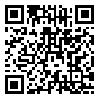Volume 18, Issue 1 (March 2020)
Iranian Rehabilitation Journal 2020, 18(1): 57-64 |
Back to browse issues page
Download citation:
BibTeX | RIS | EndNote | Medlars | ProCite | Reference Manager | RefWorks
Send citation to:



BibTeX | RIS | EndNote | Medlars | ProCite | Reference Manager | RefWorks
Send citation to:
Mousavi S Z, Mehri A, Nabavi D, Faraji M, Maroufizadeh S. Comparing the Diadochokinetic Rate in Farsi-Speaking Young and Older Adults. Iranian Rehabilitation Journal 2020; 18 (1) :57-64
URL: http://irj.uswr.ac.ir/article-1-986-en.html
URL: http://irj.uswr.ac.ir/article-1-986-en.html
1- Department of Speech Therapy, School of Rehabilitation Sciences, Iran University of Medical Sciences, Tehran, Iran.
2- Department of Speech Therapy, School of Rehabilitation, Tehran University of Medical Sciences, Tehran, Iran.
3- Department of Speech Therapy, University of Welfare and Rehabilitation Sciences, Tehran, Iran.
4- School of Nursing and Midwifery, Guilan University of Medical Sciences, Rasht, Iran.
2- Department of Speech Therapy, School of Rehabilitation, Tehran University of Medical Sciences, Tehran, Iran.
3- Department of Speech Therapy, University of Welfare and Rehabilitation Sciences, Tehran, Iran.
4- School of Nursing and Midwifery, Guilan University of Medical Sciences, Rasht, Iran.
Abstract: (5871 Views)
Objectives: Speech Diadochokinesis (DDK) is defined as the ability to produce repetitive and fast speech movements. This study aimed at comparing the DDK rate between Farsi-speaking young and older adults.
Methods: In this study, 244 normal adults (122 males and 122 females) were divided into two groups of young people (20-49 years) and elderly (50-69 years). DDK tasks was performed based on two ways: the participant was asked to produce /pa/,/ta/,/ka/,/pata/,/paka/,/taka/, and /pataka/ sounds in 5 s; and to repeat single syllable sounds (/pa/,/ta/,/ka/) 20 times, two syllables sounds (/pata/,/paka/,/taka/) 15 times, and a three syllables sound (/pataka/) ten times, separately and quickly. The independent T-test, one-way ANOVA, and Pearson correlation were used for data analysis.
Results: The results indicated a significant negative and weak correlation between age and all syllables in the specified time (range: -0.139 to -0.254), and a positive and weak correlation between age and time with respect to the repetition of all syllables (range: 0.121 to 0.245). There was no significant difference between genders in both ways (P>0.05).
Discussion: The results indicated different DDK rate between the young and elderly subjects that can be used as a benchmark for the diagnosis of disabled individuals in producing repetitive and fast oral movements and also as a basis for clinical assessments.
Methods: In this study, 244 normal adults (122 males and 122 females) were divided into two groups of young people (20-49 years) and elderly (50-69 years). DDK tasks was performed based on two ways: the participant was asked to produce /pa/,/ta/,/ka/,/pata/,/paka/,/taka/, and /pataka/ sounds in 5 s; and to repeat single syllable sounds (/pa/,/ta/,/ka/) 20 times, two syllables sounds (/pata/,/paka/,/taka/) 15 times, and a three syllables sound (/pataka/) ten times, separately and quickly. The independent T-test, one-way ANOVA, and Pearson correlation were used for data analysis.
Results: The results indicated a significant negative and weak correlation between age and all syllables in the specified time (range: -0.139 to -0.254), and a positive and weak correlation between age and time with respect to the repetition of all syllables (range: 0.121 to 0.245). There was no significant difference between genders in both ways (P>0.05).
Discussion: The results indicated different DDK rate between the young and elderly subjects that can be used as a benchmark for the diagnosis of disabled individuals in producing repetitive and fast oral movements and also as a basis for clinical assessments.
Article type: Original Research Articles |
Subject:
Speech therapy
Received: 2019/01/10 | Accepted: 2019/10/5 | Published: 2020/03/1
Received: 2019/01/10 | Accepted: 2019/10/5 | Published: 2020/03/1
Send email to the article author
| Rights and permissions | |
 |
This work is licensed under a Creative Commons Attribution-NonCommercial 4.0 International License. |








